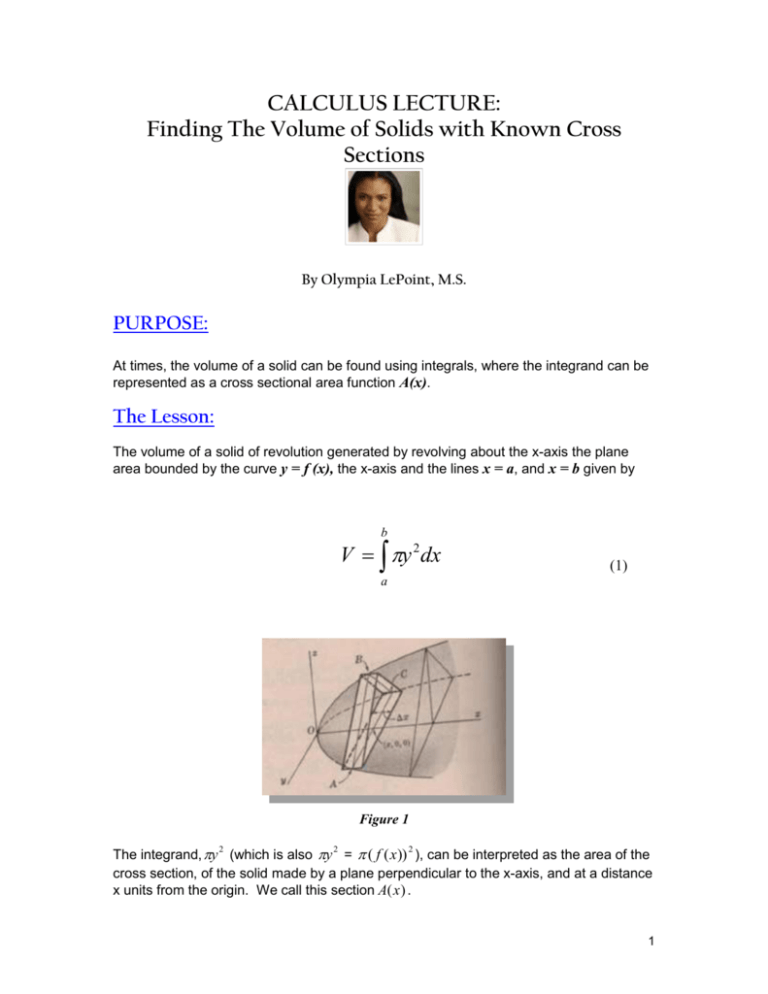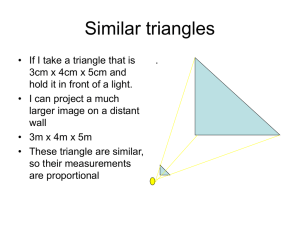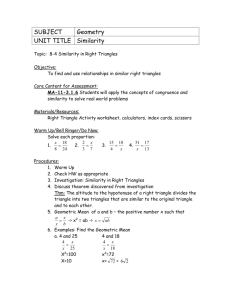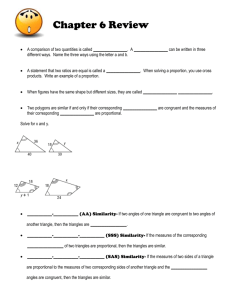The Correct Lecture 2 - faculty.piercecollege.edu
advertisement

CALCULUS LECTURE: Finding The Volume of Solids with Known Cross Sections By Olympia LePoint, M.S. PURPOSE: At times, the volume of a solid can be found using integrals, where the integrand can be represented as a cross sectional area function A(x). The Lesson: The volume of a solid of revolution generated by revolving about the x-axis the plane area bounded by the curve y = f (x), the x-axis and the lines x = a, and x = b given by b V y 2 dx (1) a Figure 1 The integrand, y 2 (which is also y 2 = ( f ( x)) 2 ), can be interpreted as the area of the cross section, of the solid made by a plane perpendicular to the x-axis, and at a distance x units from the origin. We call this section A(x ) . 1 Figure 2 In the Figure 3, the cross sectional area, A(x ) , changes based on its location within the volume of the shape. To better explain, imagine the volume from different views. If we were to view the volume as collection of triangles that are dx in width, we can construct a series of images. Figure 3 2 If each cross section area of the solid can be expressed as a function of x, say A(x ) , then the volume of the solid can be written as: b V A( x) dx (2) a Sample Problem: The base of a solid is a circular disk with radius 3. Find the volume of the solid if parallel cross-sections perpendicular to the base are isosceles right triangles with hypotenuse lying along the base. The Solution: STEP 1: Picture The Problem First above all else, we must draw the diagram to verify that we truly understand the problem. A basic figure of the problem would give the following set up. Figure 4 3 In Figure 4, A(x) represents the cross sectional area; the base is a circular disk represented by x2 + y 2 = 9 ; and dx represents the width of each triangle. The series of isosceles triangles to be formed will span the line segment started at x = -3 and ending at x = 3. STEP 2: Use The RIGHT Set Up b V A( x) dx a We must consider three aspects: 1. The limits of integration 2. The function of the base 3. The function representing the cross section area The Limits: The limits of integration a to b represents the spread of the base of the triangle from side to side a = -3 to b =3. Reference Figure 4. The Base Function: In Figure 5, the base is a solid circular disk with radius 3. By viewing the base, we gain a better picture. 4 Figure 5 The Cross Sectional Area A(x) Function: We can find A(x) by determining the base and height lengths. The hypotenuse of the triangle is along the x-axis. As a result, two triangles can be formed by bisecting the right triangle to form two 45°-45°-90° triangles. If we let y represent the length of a triangle side from the origin, the relationship implies that the base of the larger triangle is 2y and its height is y. As a result, A(x) = y 2 as seen in Figure 6. Figure 6 5 STEP 3: Solve The Problem We can now find the volume by using the information gathering in Step 1 and Step 2. 3 V A( x)dx 3 3 y 2 dx 3 3 (9 x 2 )dx 3 since y2 = 9 - x2 x3 3 9 x 3 the integral is definite 3 33 33 9(3) 9(3) 3 3 (27 9) (27 (9)) 18 (18) 36 units 3 As a result, the volume is 36 units3. In conclusion, the volume of a solid can be found using integrals where the integrand can be represented as a cross sectional area function A(x). 6








